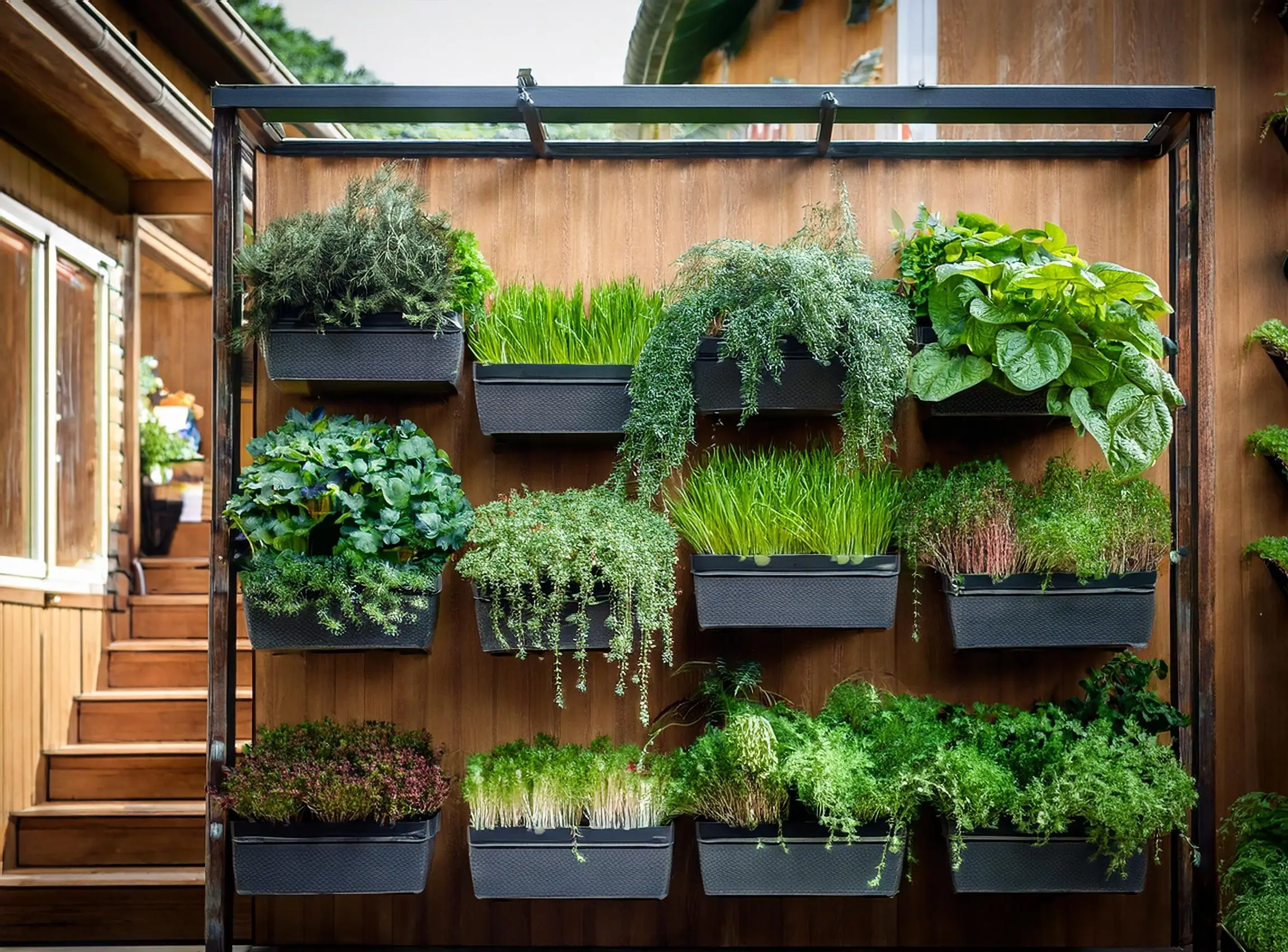
In today’s world, maximizing space is key, especially for those living in urban areas where gardens are often a luxury. Vertical gardening provides an excellent solution by allowing you to grow plants upwards rather than outwards, making the most of the limited space in your home or apartment. Whether you’re a gardening enthusiast or just starting out, vertical gardening systems can help you turn your walls or balconies into lush green spaces.
In this guide, we’ll explore the best vertical gardening systems you can use at home, how they work, and which ones are most suitable for different types of plants. By the end, you’ll clearly understand which system is best for your needs.
Why Choose Vertical Gardening?
Vertical gardening offers a range of benefits, especially for those with limited outdoor space. Here are a few reasons why you should consider starting your own vertical garden:
- Space Efficiency: Vertical gardening allows you to grow more plants in a smaller area by using vertical space, such as walls, fences, or trellises. It’s ideal for apartment dwellers or those with small backyards.
- Aesthetic Appeal: Vertical gardens add a beautiful, natural element to your living space. They can turn dull walls into vibrant green landscapes, making your home or apartment look and feel fresher.
- Improved Air Quality: Growing plants indoors or on balconies can help purify the air around you. Plants absorb carbon dioxide and release oxygen, improving indoor air quality and boosting overall well-being.
- Accessibility: A vertical garden is easier to maintain for people with limited mobility or those who prefer not to bend over to tend to ground-level gardens.
- Efficient Water Use: Some vertical gardening systems use less water than traditional gardens, as they often have built-in irrigation systems that distribute water evenly and reduce waste.
Best Vertical Gardening Systems for Home or Apartment
When it comes to vertical gardening, choosing the right system is essential for successful plant growth. Here are some of the best vertical gardening systems tailored for homes and apartments.
1. Modular Vertical Gardens
Modular vertical gardens are highly flexible systems allowing you to customize the design based on available space. These systems consist of panels or modules that can be attached to walls, fences, or any vertical surface.
- Features:
- Customizable sizes to fit different wall dimensions
- Each module holds individual pots or plant trays
- Built-in irrigation systems available for automated watering
- Suitable for a wide range of plants, from herbs to flowers and succulents
- Best For:
- Homeowners and renters who want a permanent yet customizable vertical garden solution.
- Popular Brands: Woolly Pocket, Garden on the Wall
Advantages:
- Modular gardens allow you to experiment with different plant arrangements.
- The system is easy to install and maintain.
Disadvantages:
- May require professional installation for larger setups.
- Initial costs can be higher compared to DIY options.
2. Stackable Planters
Stackable planters are another fantastic option for small spaces. These vertical gardening systems, which consist of stackable pots that allow you to grow plants in layers, are perfect for balconies or patios.
- Features:
- Easy to stack and rearrange
- Self-watering options are available
- Ideal for growing herbs, strawberries, or small vegetables
- Best For:
- Apartment dwellers or those with limited outdoor space who want a compact and portable system.
- Popular Brands: GreenStalk, Mr. Stacky
Advantages:
- Affordable and space-efficient.
- Great for growing small crops or edible plants in a small area.
Disadvantages:
- Some models lack sufficient drainage, so be mindful of overwatering.
- The stacked design may limit the root growth of larger plants.
3. Trellis Systems
A trellis system is one of the simplest and most effective vertical gardening options. It uses a trellis or lattice framework that plants climb as they grow, perfect for vining plants like tomatoes, cucumbers, and beans.
- Features:
- Made from materials like wood, metal, or plastic
- Suitable for climbing plants and vegetables
- Can be free-standing or attached to walls
- Best For:
- People looking to grow climbing or trailing plants, especially vegetables.
- Popular Brands: Panacea, Gardman
Advantages:
- Low cost and easy to install.
- Supports a wide variety of vining plants.
Disadvantages:
- Only suitable for plants that naturally climb or trail.
- Requires regular pruning and tying to keep plants under control.
4. Hanging Wall Planters
Hanging wall planters are a stylish and modern way to add a vertical garden to your home or apartment. These systems consist of fabric or plastic pockets attached to a wall, allowing plants to grow directly out of the wall.
- Features:
- Easy to install on any flat surface
- Available in a variety of sizes and configurations
- Perfect for herbs, flowers, and succulents
- Best For:
- Renters need a temporary vertical garden solution that doesn’t require permanent installation.
- Popular Brands: WallyGro, Algreen
Advantages:
- Affordable and easy to install.
- Excellent for small indoor herb gardens or decorative plants.
Disadvantages:
- Some hanging planters may not retain water well, leading to drying out.
- It is not suitable for plants that require deep roots.
5. Hydroponic Vertical Systems
For those interested in growing vegetables and herbs without soil, hydroponic vertical systems are the way to go. These systems use nutrient-rich water instead of soil to grow plants, making them efficient and space-saving.
- Features:
- No soil required – plants grow in water
- Built-in lighting and irrigation systems are available
- Best for growing leafy greens, herbs, and tomatoes
- Best For:
- Indoor gardeners who want a low-maintenance system that produces a high yield in a small space.
- Popular Brands: Tower Garden, AeroGarden
Advantages:
- Highly productive and efficient, especially for edible plants.
- Minimal mess due to the lack of soil.
Disadvantages:
- Initial costs can be high, especially for systems with built-in lighting.
- Some knowledge of hydroponics is required to maintain it properly.
6. Ladder Shelves or A-Frames
If you’re looking for a simple yet effective vertical gardening system, ladder shelves or A-frame structures are excellent options. These systems offer multiple tiers where you can place potted plants, allowing you to utilize vertical space efficiently.
- Features:
- Multi-tiered shelves for plant placement
- Can be made of wood, metal, or plastic
- Great for herbs, flowers, and small vegetables
- Best For:
- For gardeners who want a budget-friendly, DIY solution that can be placed indoors or outdoors,
- Popular Brands: VIVOSUN, Giantex
Advantages:
- Simple, affordable, and versatile.
- Easy to move and rearrange based on your space and lighting needs.
Disadvantages:
- May not provide enough space for large plants.
- Needs frequent watering since pots dry out faster on open shelves.
Choosing the Right Vertical Gardening System
When selecting the best vertical gardening system for your home or apartment, consider the following factors:
- Space: How much vertical space do you have available? Larger systems like modular gardens may be more suitable for walls, while stackable planters or trellises work well in smaller areas.
- Type of Plants: The plants you want to grow will determine your desired system. For example, hydroponic systems are perfect for leafy greens, while trellis systems are best for vining plants.
- Maintenance: Some systems, such as hydroponics, require more maintenance and technical knowledge while hanging wall planters and ladder shelves require relatively low maintenance.
- Budget: Vertical gardening systems vary in price. Trellises and stackable planters are budget-friendly, while hydroponic systems and modular gardens may require more investment.
Conclusion
Vertical gardening is a practical and aesthetically pleasing solution for those looking to maximize their space, especially in homes and apartments. You can transform your living space into a lush, green oasis by choosing the right vertical gardening system. Whether you opt for a DIY ladder shelf, a hydroponic tower, or a sleek modular system, a vertical gardening solution is perfect for your needs.

